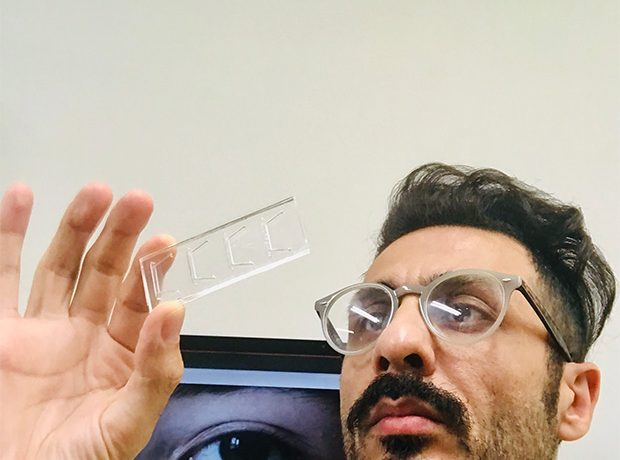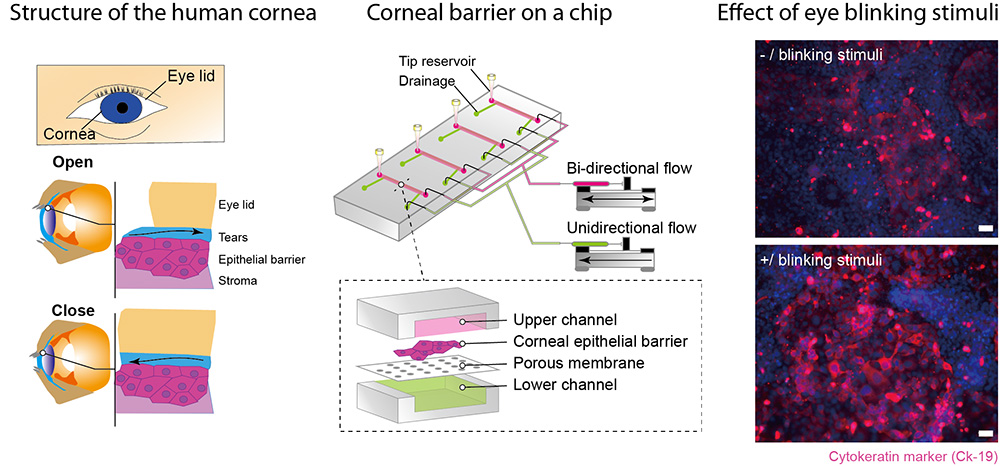“Move the Tear” for Functional Cornea-on-Chip
Program-Specific Assistant Professor (Kamei Lab)
Rodi Abdalkader
Rodi Abdalkader
Dr Rodi Abdalkader is a Program-Specific Assistant Professor at the Kamei lab, iCeMS. He studies the development of biomimetic biological barriers, and he has used microfluidic technology to recapitulate the corneal barrier under a stimulus that mimics eye blinking. In addition, he found that blinking regulates the functionality of the corneal epithelial barrier.

Please share with us the significance of your manuscript in terms of its research achievements, impact, or uniqueness.
I developed a microfluidic device that enables the creation of biomimetic human multi-corneal barriers on a single device. This design is suitable for the application of two types of flows, unidirectional and bidirectional, which mimic the shear stresses of eye blinking. The application of blinking stimuli facilitated the production of intermediate filament cytokeratin (CK-19; epithelial marker), indicating a phenotypic change in human corneal epithelial cells. These results confirm that shear stress caused by blinking alters the characteristics of corneal epithelial cells. Therefore, it is essential to consider flow stimuli when constructing models of the corneal epithelial barrier. I believe this platform will open further possibilities in the field of ocular drug development and facilitate future investigations of the effect of blinking-induced shear stress on the homeostasis of the ocular surface.
What would you say is the most exciting or “I made it!” moment during this research project?
I started this project with the basic question, “Can we make a blinking eye in vitro?” In fact, I had experience in establishing human eye barriers in vitro (eg, corneal epithelial barrier), but it was challenging to re-create a mechanical blinking stimulus. That is because, blinking is an intricate process controlled by many parameters that could not be tested in conventional in vitro models. Moreover, the biological effect of blinking in vitro was not clear to me. Still, because we blink frequently on a daily basis, I reasoned that the frontier corneal barrier must have the biological ability to cope with shear stress forces produced by blinking, thereby maintaining the homeostasis of the cornea. After several trials, I came up with a method for mimicking a blinking stimulus in situ in a microfluidic device using bidirectional flow system. The most exciting moment was when I proved this experimentally. My results showed that it is possible to induce a blinking stimulus in vitro, and that this stimulus is critical for maintaining the integrity of the corneal epithelial barrier.

Please tell us about the biggest challenge or problem you experienced while conducting your research. How did you overcome it?
In research, there is always a large gap between the research concept and the experimental tools needed to demonstrate the idea, and this project was no exception. For instance, I needed to establish a microfluidic device that is compatible with human corneal cells, capable of generating a blinking stimulus, and suitable for use in pharmaceutical applications such as drug testing. To do that, I had to learn how to create this device from scratch, starting from the design and microfabrication, and eventually testing it on human corneal cells. I believe that patience, persistence, stepwise experimentation, and above all, imagination helped me to overcome most of the challenges!
Would you consider this work to be a turning point in your overall research direction? If so, how has your research direction changed as a result of this work?
Yes, it is. This work is an excellent example of interdisciplinary research that combines biology, pharmaceutical sciences, and engineering, which will be my research direction from now on. I believe that such multidisciplinary research will bring the right solution in the future for many healthcare issues that concern our society, such as the development of disease models as alternatives for animal experiments.
Please describe the current situation of your career. What is your current position? How has the knowledge and experience gained at iCeMS influencing your career?
I am a Program-Specific Assistant Professor right now. Undoubtedly, iCeMS is the right place to start my interdisciplinary research. The work environment is very inspiring and motivational. Scientists in iCeMS are from different scientific backgrounds such as Material Sciences, Chemistry, and Biology. Therefore, we have the chance to learn from each other and collaborate at the same time. I also became more experienced in the acquisition of independent external funds. Being here also helped me figure out a clear direction for the next stage of my career, hopefully including securing a PI position in the future!
Paper information
Multi-corneal barriers-on-a-chip to recapitulate eye blinking shear stress forces
Abdalkader, R, Kamei, K
Lab on a Chip
Published: March 2019
DOI: 10.1039/c9lc01256g